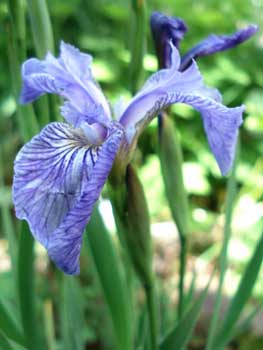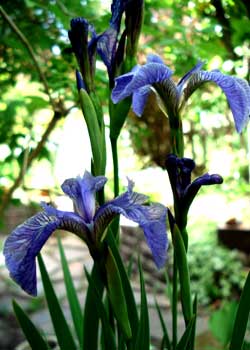
'Pristine Blue' Beachhead Iris
or Arctic Flag
"O flower-de-luce, bloom on, & let the river
Linger to kiss thy feet!
O flower of song, bloom on, & make forever
The world more fair & sweet."
-Henry Wadsworth Longfellow
(1807-1882)
Iris setosa 'Pristine Blue' is a miniature iris eight or ten inches tall, which is slightly smaller than the species. The somewhat arching grass is about the same height but parting away from the upright flower stems to insure gorgeous display unhindered by leaves in the way.(1807-1882)
 In our garden it is flower in May, but in its northern range would wait until June. Seeds ripen in July (August further north). The seed does not store well & should be planted in coldframes almost immediately upon ripening, & can be transferred to the garden the middle of the following spring (or in late spring/early summer further north).
In our garden it is flower in May, but in its northern range would wait until June. Seeds ripen in July (August further north). The seed does not store well & should be planted in coldframes almost immediately upon ripening, & can be transferred to the garden the middle of the following spring (or in late spring/early summer further north).The color range of this wild native Iris is varied, but in nature most commonly a rich deep blue with white throat, to deep violet-purple. 'Pristine Blue' however, which is the commonest named cultivar, is a clear pale sky blue with dark blue veins.
The rhizome is very shallowly rooted & even likes to have the top edge bared to the atmosphere. Root division can be done early autumn as often as annually but probably more like every third year, or whenever the clump has spread so much that the center no longer blooms well.
If only divided into thirds or quarters it can be put right back in the garden at once, but if divided very small for maximum number of plants, these should be coldframed until the following spring.
It likes bright shade where it can be drought hardy though preferring moist well-draining soil (but surprisingly adaptable to bog gardens too). It does well in just about any sort of soil except alkaline or completely dry. It will do nicely in full sun but won't be as drought hardy.
As a native of Alaska, it is extremely cold-hardy; minus thirty degrees F. wouldn't kill it. When grown in mild conditions like our temperate garden on Puget Sound, the leaves are evergreen & never turn to straw as do Siberian irises, but it's a good idea to trim back the leaves before winter's end to let it refresh itself in spring.
The species goes by a variety of common names. It's called Beach Flag or Beachhead Iris because it is tolerant of salt air or maritime conditions, encountered in rocky ground above shorelines. It's known as Arctic Iris or Alaska Flag because it grows into the Arctic circle, & formerly possessed the taxonomic name Iris arctica. It's also known merely as Blue Flag or Wild Dwarf Iris, occasionally Hairy Iris as the species name setosa means "hairy."
The root as with other irises is toxic, though the idea that irises are deer-proof is greatly exaggerated. If more ideal browsings aren't available, deer will eat iris leaves with abandon, & being deer-proof only means they'll grow back.
Despite toxicity the root can be bounded into an edible starch that loses its poisonous when cooked. Uncooked it will cause diarrhea, & aboriginal peoples used it as a cure for constipation. Traditionally the seeds have been used as a coffee substitute, roasted & ground, & is surprisingly tasty.